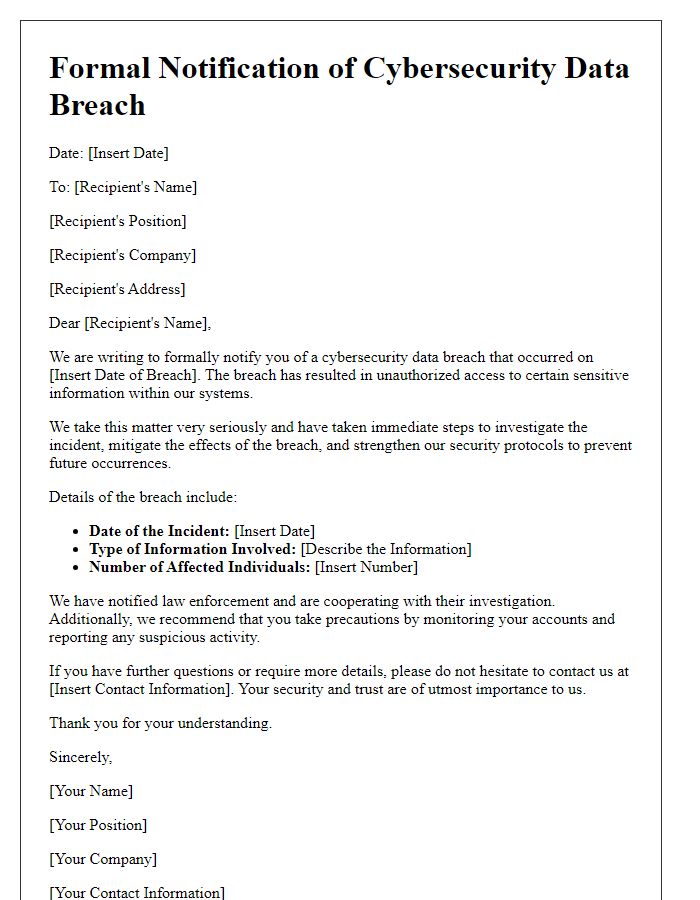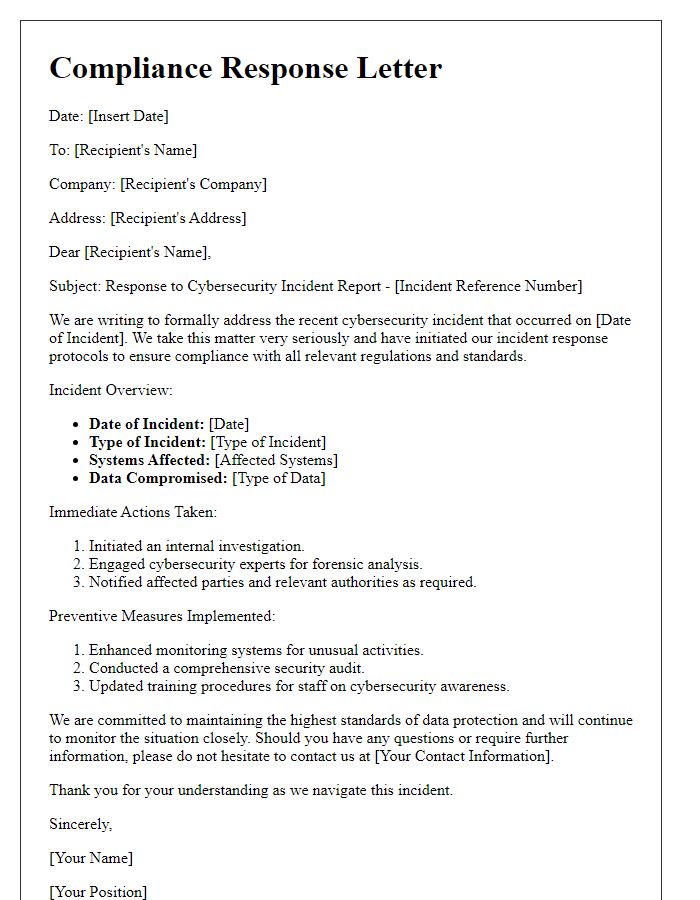In today's digital landscape, the threat of cybersecurity breaches is a reality that many organizations face, leaving them grappling with the legal ramifications in their wake. When such an incident occurs, it's crucial to have a well-structured legal response in place to navigate the complex web of regulations, potential liabilities, and necessary communication. A carefully crafted letter outlining the situation and the steps being taken can effectively address stakeholder concerns and demonstrate your commitment to transparency. Curious about how to create an impactful legal response to a cybersecurity breach? Read more to discover practical tips and a robust template for your needs!

Identification of Breach
A cybersecurity breach can significantly compromise sensitive data, potentially affecting thousands of individuals and organizations. On [specific date], a breach was identified involving unauthorized access to [specific system or network, e.g., corporate email servers or customer databases] utilized by [organization name]. Preliminary investigations indicate that the breach may have exposed personal identifiable information (PII), including names, addresses, and Social Security numbers. The suspected methods of access involved sophisticated phishing attacks, targeting employees in [location or department]. Immediate steps taken include notifying law enforcement, engaging forensic experts to assess the extent of the breach, and implementing measures to secure affected systems effectively. Continuous monitoring and communication with impacted parties remain a priority as responses and updates unfold.
Legal Obligations and Compliance
A cybersecurity breach can significantly impact organizations, especially regarding legal obligations and compliance requirements. Organizations must adhere to regulations such as the General Data Protection Regulation (GDPR), which imposes strict penalties for data breaches affecting EU citizens and requires reporting within 72 hours. Moreover, the Health Insurance Portability and Accountability Act (HIPAA) sets forth specific guidelines for handling patient information, necessitating timely notifications to affected individuals, typically within 60 days. Various states in the U.S. have enacted data breach notification laws, mandating that businesses inform residents about breaches affecting personal information, generally within a specified timeframe after detection. Compliance with industry standards, such as the Payment Card Industry Data Security Standard (PCI DSS), also plays a critical role in mitigating legal risks and ensuring customer data protection in the financial sector. Failure to comply with these legal requirements can result in substantial fines, reputational damage, and potential lawsuits.
Notification Procedures
In response to a cybersecurity breach impacting sensitive data, organizations must establish efficient notification procedures to comply with legal requirements. Timely communication is essential to mitigate potential harm to affected individuals. Entities must identify the nature of the breach, including the types of compromised information, such as Social Security numbers or financial account details. Legal frameworks, such as the General Data Protection Regulation (GDPR) in the European Union and various state laws in the United States, mandate notification within specific timeframes, often within 72 hours of discovery. Affected individuals should receive clear communication detailing the breach's nature, potential risks, and steps being taken to address the situation. Additionally, offering resources such as identity theft protection services can help restore confidence among the affected parties. Compliance with notification requirements not only fulfills legal obligations but also fosters transparency and trust within the organization's stakeholder community.
Mitigation Measures
In the aftermath of a cybersecurity breach, organizations must undertake swift mitigation measures to protect sensitive data and restore security. Immediate actions should include notifying affected individuals, especially if personal information or financial data has been compromised. Depending on the scale of the breach, engaging with cybersecurity experts or firms specializing in incident response, such as FireEye or CrowdStrike, is crucial for assessing vulnerabilities. Implementing stronger access controls, including multi-factor authentication systems, can significantly reduce the risk of future incidents. Additionally, conducting thorough audits of existing security protocols and training employees on phishing and social engineering tactics can enhance overall security awareness. Regularly updating software and firewalls, along with continuous monitoring of network activity, will bolster defenses against potential follow-up attacks. Furthermore, documenting all responses and measures taken post-breach is essential for legal compliance and future reference in case of litigation or regulatory scrutiny.
Future Prevention Plans
A comprehensive future prevention plan is essential in the wake of a cybersecurity breach, focused on enhancing the organization's security posture. Implementing multi-factor authentication (MFA) across all user accounts minimizes unauthorized access risks, while regular security audits bolster vulnerability assessments to identify potential weak points in systems. Employee training programs emphasize phishing awareness and secure data handling techniques, reducing human error as a contributing factor to breaches. Upgrading firewalls and intrusion detection systems ensures advanced threat monitoring and response capabilities. Furthermore, developing a robust incident response plan allows for swift action in the event of future breaches, mitigating potential damage. Regularly updating software and infrastructure, including patch management, is crucial for protecting against exploits targeting known vulnerabilities in applications and operating systems. Establishing a data encryption policy safeguards sensitive information, even in compromised scenarios, ensuring data remains secure during a breach.
Letter Template For Cybersecurity Breach Legal Response Samples
Letter template of legal response for cybersecurity breach notification.

Letter template of incident response communication for cybersecurity breach.

Letter template of formal notification regarding cybersecurity data breach.

Letter template of cybersecurity breach acknowledgement and legal guidance.

Letter template of breach response outlining affected parties and next steps.

Letter template of legal consultation request following cybersecurity breach.

Letter template of cybersecurity breach impact assessment and legal implications.

Letter template of remedial actions in response to cybersecurity breach.






Comments